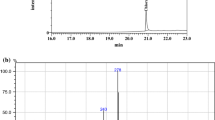Abstract
A simple residue analytical method using the quick, easy, cheap, effective, rugged, and safe (QuEChERS) procedure for the determination of trifloxystrobin and its metabolite trifloxystrobin acid (CGA321113) in tomato and soil was developed using high-performance liquid chromatography-tandem mass spectrometry (HPLC-MS/MS). The limits of detection were 0.0005 mg/kg for trifloxystrobin and 0.001 mg/kg for trifloxystrobin acid, respectively. The average recoveries in tomato and soil ranged from 73–99 % for trifloxystrobin and 75–109 % for trifloxystrobin acid, with relative standard deviations below 15 %. The method was then used to study the dissipation and residues in tomato and soil. The dissipation half-lives of trifloxystrobin in tomato were 2.9 days (Beijing) and 5.4 days (Shandong), while in soil were 1.9 days (Beijing) and 3.0 days (Shandong), respectively. The final results showed that the major residue compound was trifloxystrobin in tomato whereas it was its metabolite, trifloxystrobin acid, in soil. The final residues of total trifloxystrobin (including trifloxystrobin acid) were below the EU maximum residue limit of 0.5 mg kg−1 in tomato 3 days after the treatment.
Access this article
We’re sorry, something doesn't seem to be working properly.
Please try refreshing the page. If that doesn't work, please contact support so we can address the problem.





Similar content being viewed by others
References
Banerjee, K., Ligon, A. P., & Spiteller, M. (2006). Environmental fate of trifloxystrobin in soils of different geographical origins and photolytic degradation in water. Journal of Agricultural and Food Chemistry, 54, 9479–9487.
Carpinteiro, I., Ramil, M., Rodriguez, I., & Cela, R. (2010). Determination of fungicides in wine by mixed-mode solid phase extraction and liquid chromatography coupled to tandem mass spectrometry. Journal of Chromatography A, 1217(48), 7484–7492.
Chen, J. Y., LOO, B., & Ray, C. (2008). Determination of trifloxystrobin and its metabolites in Hawaii soils by ASE-LC-MS/MS. Journal of Agricultural and Food Chemistry, 56, 1829–1837.
Chen, X. X., Xu, J., Liu, X. G., Tao, Y., Pan, X. L., Zheng, Y. Q., & Dong, F. S. (2014). Simultaneous determination of trifloxystrobin and trifloxystrobin acid in rice and soil by a modified quick, easy, cheap, effective, rugged, and safe method using ultra high performance liquid chromatography with tandem mass spectrometry. Journal of Separation Science. doi:10.1002/jssc.201400157.
Lehotay, S. J. (2007). Determination of pesticide residues in foods by acetonitrile extraction and partitioning with magnesium sulfate: collaborative study. Journal of AOAC International, 90, 485–520.
Liang, P., Liu, G. J., Wang, F., & Wang, W. T. (2013). Ultrasound-assisted surfactant-enhanced emulsification microextraction with solidification of floating organic droplet followed by high performance liquid chromatography for the determination of strobilurin fungicides in fruit juice samples. Journal of Chromatography B-Analytical Technologies in the Blomedical and Life Sciences, 926, 62–67.
Pesticide Porperties Database (PPDB), trifloxystrobin (Ref: CGA 279202) (http://sitem.herts.ac.uk/aeru/ppdb/en/index.htm) updated: 09 September 2013.
Rao, T. N., Ramesh, A., Parvathamma, T., & Suresh, G. (2012). Development and validation of a HPLC-UV method for simultaneous determination of strobilurin fungicide residues in tomato fruits followed by matrix solid-phase dispersion (MSPD). Indian Journal of Scientific Research, 3(1), 113–118.
U.S. EPA (1999) Pesticide fact sheet: trifloxystrobin.
Wang C (2011). Study on dissipation for trifloxystrobin and its metabolite in apple and potato. (Master thesis) China Agricultural University, Beijing, China.
Zhang, W. W., Xu, J., Dong, F. S., Liu, X. G., Zhang, Y., Tao, Y., Wu, X. H., & Zheng, Y. Q. (2013a). Simultaneous determination of three strobilurin fungicide residues in fruits, vegetables and soil by a modified quick, easy, cheap, effective, rugged (QuEChERS) method coupled with gas chromatography-tandem mass spectrometry. Analytical Methods, 5(24), 7102–7109.
Zhang, Y. L., Huang, C. Q., Zhu, X. Y., Chen, X. M., & Mo, W. M. (2013b). Determination of seven strobilurin fungicide residues in Chinese herbs by liquid chromatography-tandem mass spectrometry coupled with solid phase extraction. Chinese Journal of Chromatography, 31(3), 264–269.
Zhu, X. L., Gao, Y., & Su, Q. D. (2004). Determination of nonvolatile organic acid, fatty acid and low molecular sugars in tomato by capillary gas chromatography. Food Science, 25(9), 152–157.
Author information
Authors and Affiliations
Corresponding author
Rights and permissions
About this article
Cite this article
Wang, L., Li, W., Li, P. et al. Residues and dissipation of trifloxystrobin and its metabolite in tomatoes and soil. Environ Monit Assess 186, 7793–7799 (2014). https://doi.org/10.1007/s10661-014-3967-3
Received:
Accepted:
Published:
Issue Date:
DOI: https://doi.org/10.1007/s10661-014-3967-3




